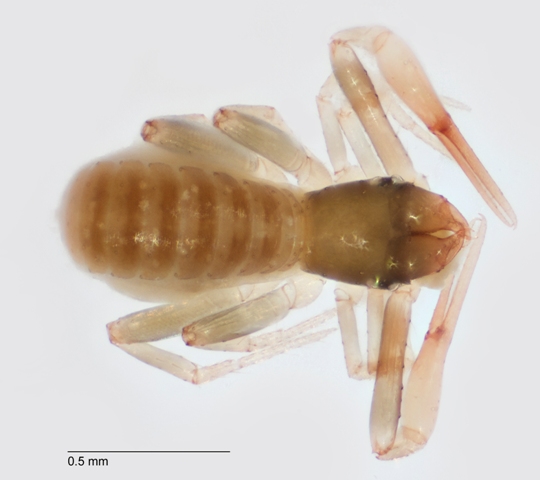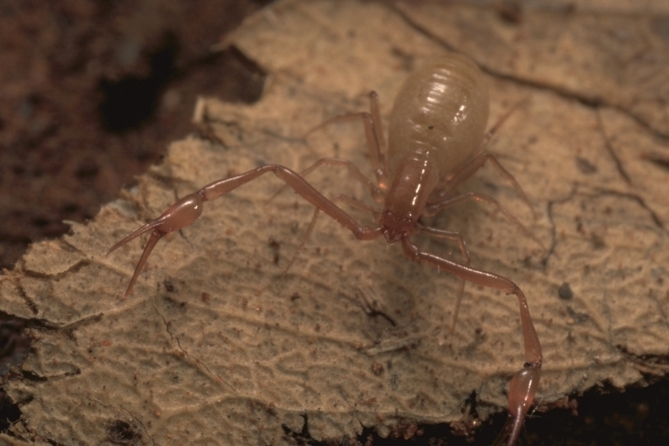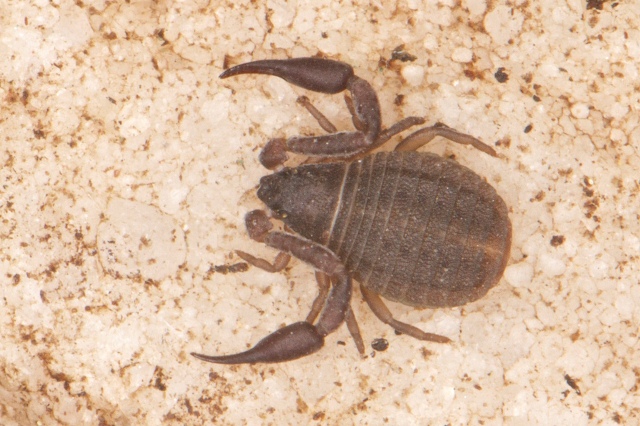Phylum Arthropoda
Subphylum Chelicerata
Class Arachnida
Order Pseudoscorpiones
Common name: pseudoscorpions
Overview
Pseudoscorpions are small arachnids that rarely exceed 10 mm in length, and most are smaller than 3 mm. They possess chelate, often heavily sclerotised, pincer-like pedipalps that give them a superficial resemblance to scorpions. Pseudoscorpions differ from scorpions in many ways, the most notable being their lack of a stinging telson (tail), and elongated metasoma. The eyes can be absent, in two pairs or in one pair, always on the anterior half of the carapace. While pseudoscorpions lack the stinging telson of true scorpions, many possess venomous pedipalps. Like spiders, most pseudoscorpions can produce silk, however it is produced from structures on the chelicerae, and there are no abdominal spinnerets. Silk is only used for the construction of moulting and breeding retreats, and in some species males produce silk structures in association with their spermatophores (sperm packets). Silk is not used for dispersal as for spiders, however many species are phoretic in that they cling to a larger animals (usually insects) to disperse (by �hitchhiking�) from one place to another.
Distribution and diversity
Pseudoscorpions have a continent-wide distribution in Australia. Globally there are over 3,400 species described, while Australia has more than 170 described species in about 60 genera (accommodated in 18 families). However, recent research has uncovered a diverse fauna on the continent and its true size is probably close to 750 species.
Life cycle
Mating is variable in pseudoscorpions and all males produce a spermatophore. In many species, this structure is simply deposited on a suitable substrate, and left for a female to find. Some species create silken guides to assist the females to find their spermatophores. The female then takes the spermatophore into her genital opening. Other pseudoscorpions engage in a short ritualised courtship �dance� during which the male grips the female pedipalps with his, deposits a spermatophore, and positions her over it until it is taken up. The eggs are laid into a brood sac, which remains attached to the female gonopore. After hatching, the juveniles leave their mother and are independent. Three moults occur before sexual maturity is achieved.
Feeding
All pseudoscorpions are predatory, and prey consists of small to relatively large invertebrates (two or three times pseudoscorpion body size). Prey is captured with the pedipalps through which many species inject venom to subdue their prey. The chelicerae are used to create a hole through the exoskeleton into which digestive enzymes are passed. The chelicerae and the base (coxa) of the pedipalps form a short tube through which the pre-orally digested contents are sucked up.
Ecology
Pseudoscorpions are often found under the dry bark of certain trees, as well as under rocks and in leaf litter or in caves. As predators their effect on small invertebrates is thought to be significant. However, as with many other small invertebrates, their small size makes their ecological role difficult to study and their true impact on is still largely unknown. Some species have been observed in human dwellings, but they do not cause any damage. Pseudoscorpions are not known to have any commercial significance.

Pseudoscorpion
Image credit: � Sophie Harrison
used with permission

Pseudoscorpion
Image credit: Photographer: Erich S. Volschenk
� Western Australian Museum

Pseudoscorpion
Image credit: Photographer: D. Elford
� Western Australian Museum










